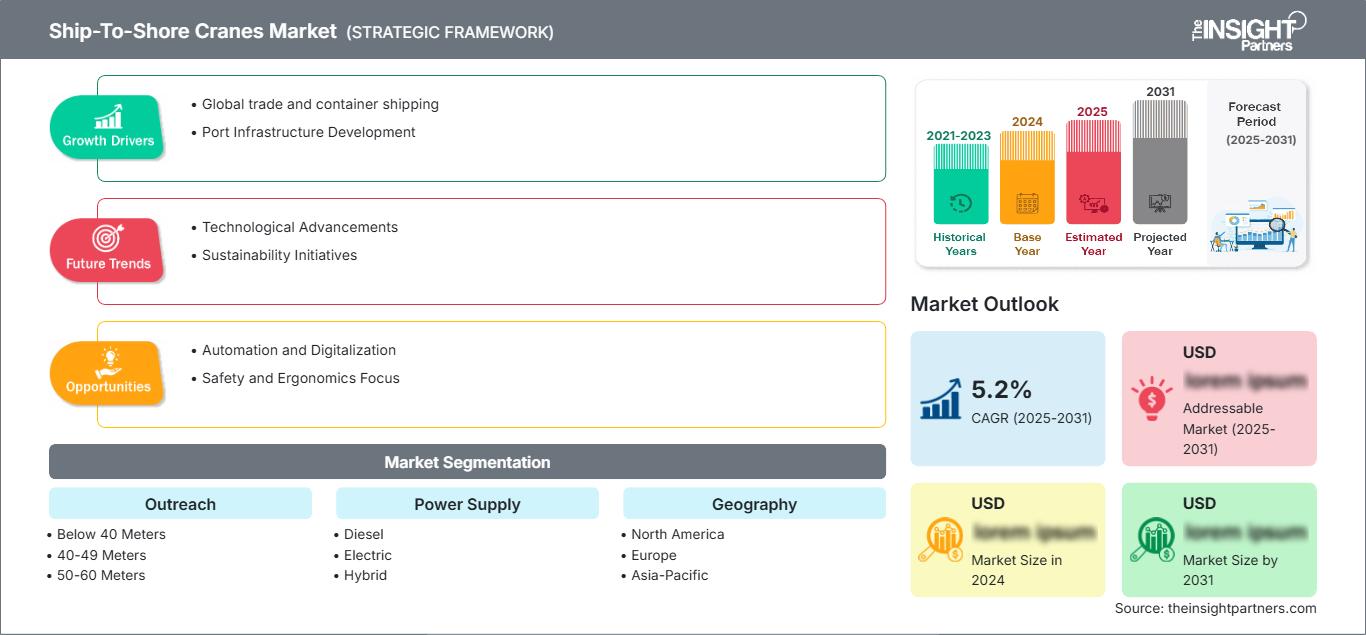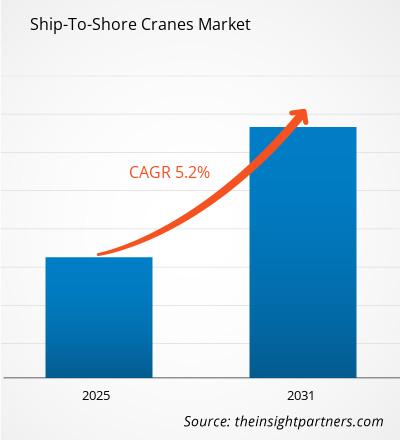Der Markt für Ship-To-Shore-Krane wird voraussichtlich zwischen 2025 und 2031 eine durchschnittliche jährliche Wachstumsrate (CAGR) von 5,2 % verzeichnen, wobei die Marktgröße von XX Millionen US-Dollar im Jahr 2024 auf XX Millionen US-Dollar im Jahr 2031 anwachsen wird.
Der Bericht ist nach Reichweite segmentiert (unter 40 Meter, 40–49 Meter, 50–60 Meter, über 60 Meter). Der Bericht präsentiert außerdem eine Analyse basierend auf der Stromversorgung (Diesel, Elektro, Hybrid). Die globale Analyse ist weiter auf regionaler Ebene und nach den wichtigsten Ländern aufgeschlüsselt. Der Bericht bietet den Wert in USD für die oben genannte Analyse und Segmente.
Zweck des Berichts
Der Bericht „Ship-To-Shore-Krane-Markt“ von The Insight Partners zielt darauf ab, die aktuelle Situation und das zukünftige Wachstum sowie die wichtigsten treibenden Faktoren, Herausforderungen und Chancen zu beschreiben. Dadurch erhalten verschiedene Geschäftsinteressenten Einblicke, beispielsweise:
- Technologieanbieter/-hersteller: Um die sich entwickelnde Marktdynamik zu verstehen und die potenziellen Wachstumschancen zu kennen, sodass sie fundierte strategische Entscheidungen treffen können.
- Investoren: Um eine umfassende Trendanalyse hinsichtlich der Marktwachstumsrate, der finanziellen Marktprognosen und der Chancen entlang der Wertschöpfungskette durchzuführen.
- Regulierungsbehörden: Um Richtlinien und Überwachungsaktivitäten auf dem Markt zu regulieren, mit dem Ziel, Missbrauch zu minimieren, das Vertrauen der Investoren zu wahren und die Integrität und Stabilität des Marktes aufrechtzuerhalten.
Marktsegmentierung für Ship-To-Shore-Kräne
- Unter 40 Metern
- 40–49 Metern
- 50–60 Metern
- Über 60 Metern
Stromversorgung
- Diesel
- Elektrisch
- Hybrid
Sie erhalten kostenlos Anpassungen an jedem Bericht, einschließlich Teilen dieses Berichts oder einer Analyse auf Länderebene, eines Excel-Datenpakets sowie tolle Angebote und Rabatte für Start-ups und Universitäten.
Markt für Ship-To-Shore-Kräne: Strategische Einblicke

-
Holen Sie sich die wichtigsten Markttrends aus diesem Bericht.Dieses KOSTENLOSE Beispiel umfasst Datenanalysen, die von Markttrends bis hin zu Schätzungen und Prognosen reichen.
Wachstumstreiber für den Markt für Schiffsverladekräne
- Welthandel und Containerschifffahrt: Das Wachstum des Welthandels sowie höhere Containerschifffahrtsvolumina sind eine der wichtigsten Triebkräfte dieses Marktes. Der Grund dafür ist, dass heutzutage größere Schiffe mit größeren Transportvolumina Häfen anlaufen, was zu einer höheren Nachfrage nach effizienten und zuverlässigen Kränen zum Ent- und Beladen von Containern führt.
- Entwicklung der Hafeninfrastruktur: Steigende Investitionen in die Hafeninfrastruktur und Modernisierungsprogramme weltweit erhöhen die Nachfrage nach Schiffsverladekränen. Häfen müssen ihre Anlagen modernisieren und aufrüsten, um sie für größere Schiffe zu nutzen und ihre Betriebseffizienz zu steigern, wofür sie fortschrittliche Kransysteme benötigen.
Zukünftige Trends im Markt für Schiffsverladekräne
- Technologischer Fortschritt: Neue technologische Entwicklungen wie Automatisierung, Fernsteuerung und intelligente Sensoren in Kränen bergen Potenzial für die Expansion des Marktes. Hersteller mit fortschrittlichen Systemen zur Verbesserung der Effizienz und der Sicherheit sowie der Betriebsleistung werden sich einen Wettbewerbsvorteil auf dem Markt verschaffen.
- Nachhaltigkeitsinitiativen: Die Forderung nach nachhaltiger und CO2-armer Schifffahrt öffnet die Türen für umweltfreundliche Ship-to-Shore-Krane. Alle Unternehmen, die umweltfreundliche Kräne entwickeln oder alternative Energien wie Elektro- oder Hybridenergie nutzen, können mehr „grüne“ Kunden gewinnen.
Marktchancen für Ship-to-Shore-Krane
- Automatisierung und Digitalisierung: Der Hafenbetrieb wird in vielen Fällen automatisiert und digital gesteuert. Der Einsatz automatisierter Ship-to-Shore-Krane nimmt zu, und diese modernen Kräne sind mit überlegenen Steuerungssystemen ausgestattet, um die Genauigkeit zu verbessern, während gleichzeitig die Arbeitskosten minimiert und der gesamte Betrieb weiter rationalisiert werden.
- Fokus auf Sicherheit und Ergonomie: Der Fokus auf Sicherheits- und Ergonomiemerkmale bei der Krankonstruktion steigt deutlich an. Es gibt verbesserte Sicherheitsfunktionen wie verbesserte Sicht, fortschrittliche Steuerungssysteme und ein ergonomisches Design, die dazu beitragen, Unfälle zu reduzieren und die Arbeitsbedingungen zu verbessern.
Markt für Ship-to-Shore-Krane
Die Analysten von The Insight Partners haben die regionalen Trends und Faktoren, die den Markt für Ship-To-Shore-Krane im Prognosezeitraum beeinflussen, ausführlich erläutert. In diesem Abschnitt werden auch die Marktsegmente und die geografische Lage in Nordamerika, Europa, im asiatisch-pazifischen Raum, im Nahen Osten und Afrika sowie in Süd- und Mittelamerika erörtert.Umfang des Marktberichts zu Ship-to-Shore-Kranen
| Berichtsattribut | Einzelheiten |
|---|---|
| Marktgröße in 2024 | US$ XX million |
| Marktgröße nach 2031 | US$ XX Million |
| Globale CAGR (2025 - 2031) | 5.2% |
| Historische Daten | 2021-2023 |
| Prognosezeitraum | 2025-2031 |
| Abgedeckte Segmente |
By Reichweite
|
| Abgedeckte Regionen und Länder |
Nordamerika
|
| Marktführer und wichtige Unternehmensprofile |
|
Marktdichte von Ship-to-Shore-Kranen: Auswirkungen auf die Geschäftsdynamik verstehen
Der Markt für Ship-To-Shore-Krane wächst rasant. Dies wird durch die steigende Endverbrauchernachfrage aufgrund veränderter Verbraucherpräferenzen, technologischer Fortschritte und eines stärkeren Bewusstseins für die Produktvorteile vorangetrieben. Mit der steigenden Nachfrage erweitern Unternehmen ihr Angebot, entwickeln Innovationen, um den Bedürfnissen der Verbraucher gerecht zu werden, und nutzen neue Trends, was das Marktwachstum weiter ankurbelt.
- Holen Sie sich die Markt für Ship-To-Shore-Kräne Übersicht der wichtigsten Akteure
Wichtige Verkaufsargumente
- Umfassende Abdeckung: Der Bericht analysiert umfassend Produkte, Dienstleistungen, Typen und Endnutzer des Marktes für Schiffsverlegungskräne und bietet einen ganzheitlichen Überblick.
- Expertenanalyse: Der Bericht basiert auf dem umfassenden Verständnis von Branchenexperten und Analysten.
- Aktuelle Informationen: Der Bericht gewährleistet Geschäftsrelevanz durch die Berichterstattung über aktuelle Informationen und Datentrends.
- Anpassungsoptionen: Dieser Bericht kann an spezifische Kundenanforderungen angepasst werden und passt sich optimal an die Geschäftsstrategien an.
Der Forschungsbericht zum Markt für Schiffsverlegungskräne kann daher dazu beitragen, die Branchensituation und die Wachstumsaussichten zu entschlüsseln und zu verstehen. Obwohl es einige berechtigte Bedenken geben kann, überwiegen die Vorteile dieses Berichts tendenziell die Nachteile.
- Historische Analyse (2 Jahre), Basisjahr, Prognose (7 Jahre) mit CAGR
- PEST- und SWOT-Analyse
- Marktgröße Wert/Volumen – Global, Regional, Land
- Branchen- und Wettbewerbslandschaft
- Excel-Datensatz
Aktuelle Berichte
Erfahrungsberichte
Grund zum Kauf
- Fundierte Entscheidungsfindung
- Marktdynamik verstehen
- Wettbewerbsanalyse
- Kundeneinblicke
- Marktprognosen
- Risikominimierung
- Strategische Planung
- Investitionsbegründung
- Identifizierung neuer Märkte
- Verbesserung von Marketingstrategien
- Steigerung der Betriebseffizienz
- Anpassung an regulatorische Trends






















 Kostenlose Probe anfordern für - Markt für Ship-To-Shore-Kräne
Kostenlose Probe anfordern für - Markt für Ship-To-Shore-Kräne